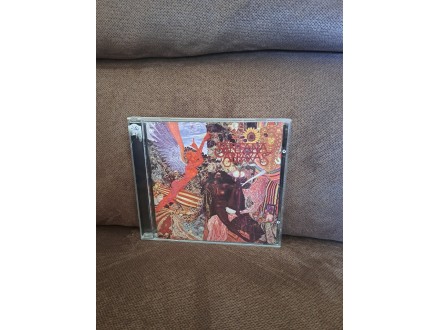Santana - Abraxas (Bonus)
| Cena: |
| Želi ovaj predmet: | 2 |
| Stanje: | Polovan bez oštećenja |
| Garancija: | Ne |
| Isporuka: | CC paket (Pošta) Post Express Lično preuzimanje |
| Plaćanje: | Tekući račun (pre slanja) Lično |
| Grad: |
Novi Sad, Novi Sad |
Izdavač: Ostalo
Žanr: Bluz, Džez, Latino, Rok
Poreklo: Strani izvođač
Original, made in EU
Knjizica od 12 str.
Odlicno ocuvano
knjizica 5 Cd 5
Izdanje sa 3 bonus numere!
Studio album by Santana
Released September 23, 1970
Recorded April 17 – May 2, 1970
Studio
Wally Heider Studios, San Francisco
Pacific Recorders, San Mateo
Genre
Latin rockChicano rockjazz fusionpsychedelic rockblues rock
Length 37:36
Language English, Spanish
Label Columbia
Producer
Fred CateroCarlos Santana
Santana chronology
Santana
(1969) Abraxas
(1970) Santana III
(1971)
Abraxas is the second studio album by Latin rock band Santana. It was released on September 23, 1970, by Columbia Records and became the band`s first album to reach number one in the United States.[1]
Title
The title of the album originates from a line in Hermann Hesse`s 1919 book Demian, quoted on the album`s back cover: `We stood before it and began to freeze inside from the exertion. We questioned the painting, berated it, made love to it, prayed to it: We called it mother, called it whore and slut, called it our beloved, called it Abraxas...`[2]
Songs
Carlos Santana had been interested in Fleetwood Mac`s leader and songwriter Peter Green, having seen him perform at the Fillmore West in San Francisco, and decided to cover the band`s song `Black Magic Woman`. Both were influenced as guitarists by B.B. King. The band added a cover of Gábor Szabó`s instrumental `Gypsy Queen` to the end.[3]: 34–35 `Oye Como Va` was a hit by Tito Puente in the early 1960s and the group played it live regularly, as they realized it was good for audiences to dance to.[3]: 35
`Incident at Neshabur` was co-written by Santana and his friend Alberto Gianquinto, who played piano on the track. Gregg Rolie played the other keyboards, contrasting with Gianquinto`s jazz-influenced style. It ran through various time and key signatures.[3]: 36
The instrumental, `Samba Pa Ti` (`Samba for You`), was written by Santana after he saw a jazz saxophonist performing in the street outside his apartment.[2]: par. 5 [3]: 36 It was later covered by José Feliciano, who added lyrics, and also by Angélique Kidjo, who put lyrics in Yoruba, on her album Oyo. It is also one of the tracks featured in Nick Hornby`s book 31 Songs.[4]
The first three songs on side one segue into each other, creating a 14-minute, 28-second mini-suite.
Cover art
The album cover features the 1961 painting Annunciation by German-French painter Mati Klarwein.[5] According to the artist, it was one of the first paintings he did after relocating to New York City. Carlos Santana reportedly noticed it in a magazine and asked that it be on the cover of the band`s upcoming album.[6] On the back of the record sleeve the cover art is just credited to `MATI`. It is now considered a classic of rock album covers.[5][7][8] Klarwein went on to design album artwork for many notable artists, including Miles Davis, Herbie Hancock, Earth, Wind & Fire, and Gregg Allman.
Track listing
Original release
Side one
No. Title Writer(s) Length
1. `Singing Winds, Crying Beasts` (Instrumental) Michael Carabello 4:51
2. `Black Magic Woman/Gypsy Queen` Peter Green/Gábor Szabó 5:24
3. `Oye Cómo Va` Tito Puente 4:17
4. `Incident at Neshabur` (Instrumental) Alberto Gianquinto, Carlos Santana 4:58
Side two
No. Title Writer(s) Length
1. `Se a Cabó` José Areas 2:50
2. `Mother`s Daughter` Gregg Rolie 4:25
3. `Samba Pa Ti` (Instrumental) Santana 4:45
4. `Hope You`re Feeling Better` Rolie 4:10
5. `El Nicoya` Areas 1:30
1998 bonus tracks
1998 remastered edition
No. Title Length
10. `Se a Cabó` (Live at the Royal Albert Hall, London, England, April 18, 1970)[21] (1998 edition) 3:47
11. `Toussaint L`Overture` (Live at the Royal Albert Hall, London, England, April 18, 1970) (1998 edition) 4:52
12. `Black Magic Woman/Gypsy Queen` (Live at the Royal Albert Hall, London, England, April 18, 1970) (1998 edition) 4:57
Santana
Carlos Santana – lead guitar, backing vocals, producer[22]
Gregg Rolie – keyboards, lead vocals
David Brown – bass
Michael Shrieve – drums
José `Chepito` Areas – percussion, conga, timbales
Michael Carabello – percussion, conga, possible keyboards on `Singing Winds, Crying Beasts`[23] (the latter disputed by Santana)[24]
Additional personnel
Rico Reyes – backing vocal on `Oye Como Va`, backing vocal and percussion on `El Nicoya`
Alberto Gianquinto – piano on `Incident at Neshabur`
Fred Catero - Producer[25]
John Fiore, David Brown – engineer
Bob Venosa – graphics
MATI – illustrations
Marian Schmidt, Joan Chase - photography
Predmet šaljem nakon uplate na moj tekući račun ili po dogovoru.
Lično preuzimanje je uvek moguce u Novom Sadu po dogovoru,ili na mojoj adresi .
Molim kupce da pre licitacije pitaju sve sto ih zanima, kako bi izbegli eventualne nesporazume.
U slučaju bilo kakvog problema nakon preuzimanja paketa, kontaktirajte me pre davanja ocene kako bi isti pokusali da rešimo.
Ne šaljem pouzećem.
Za prodaju cd-ova : Plastične kutije su zamenjive i njih NE OCENJUJEM! Takodje zadnja strana iza plastike drzaca cd je vidljiva slika, za njih isto ne ide ocena, sve se vidi!
Predmet: 77512113











